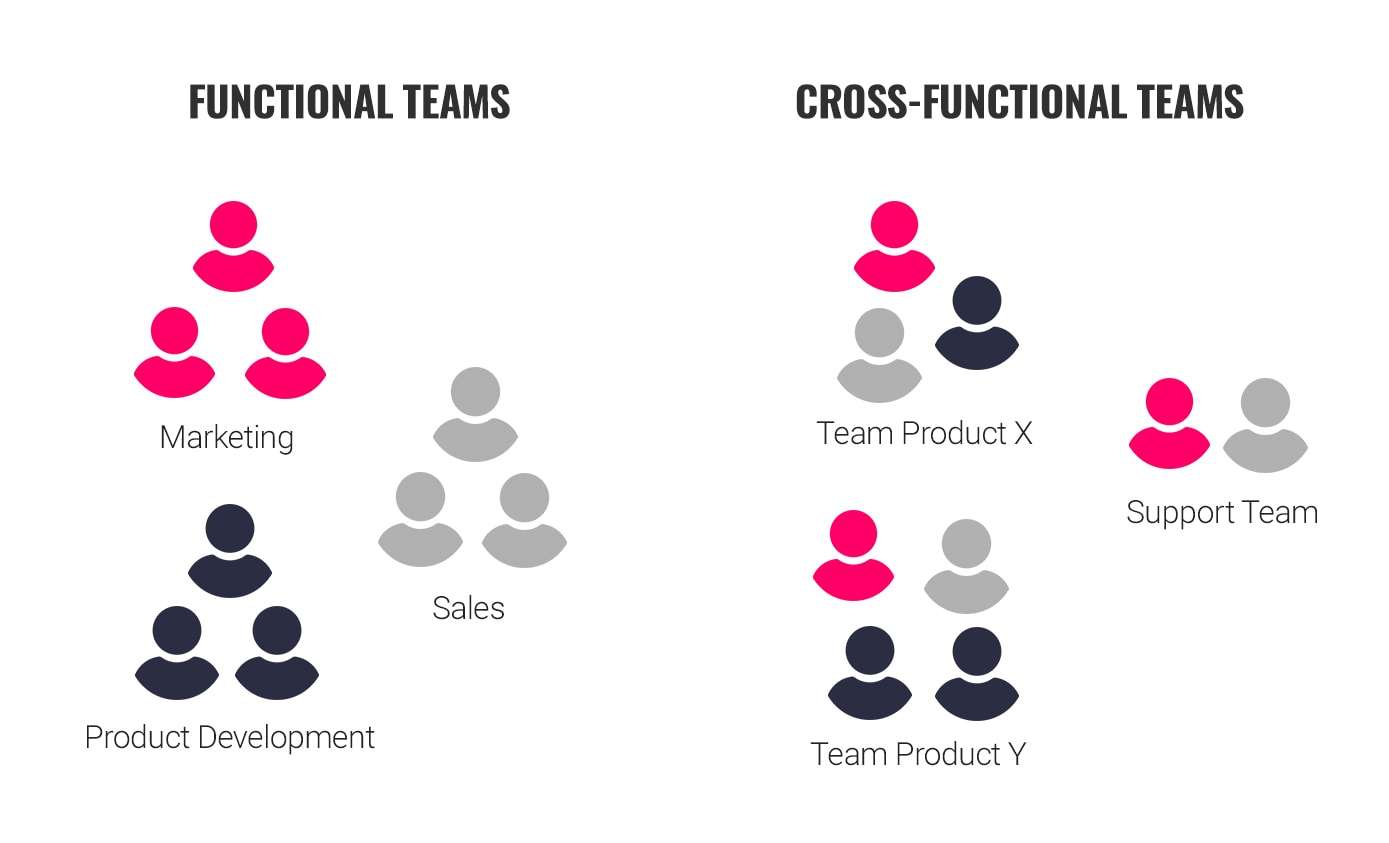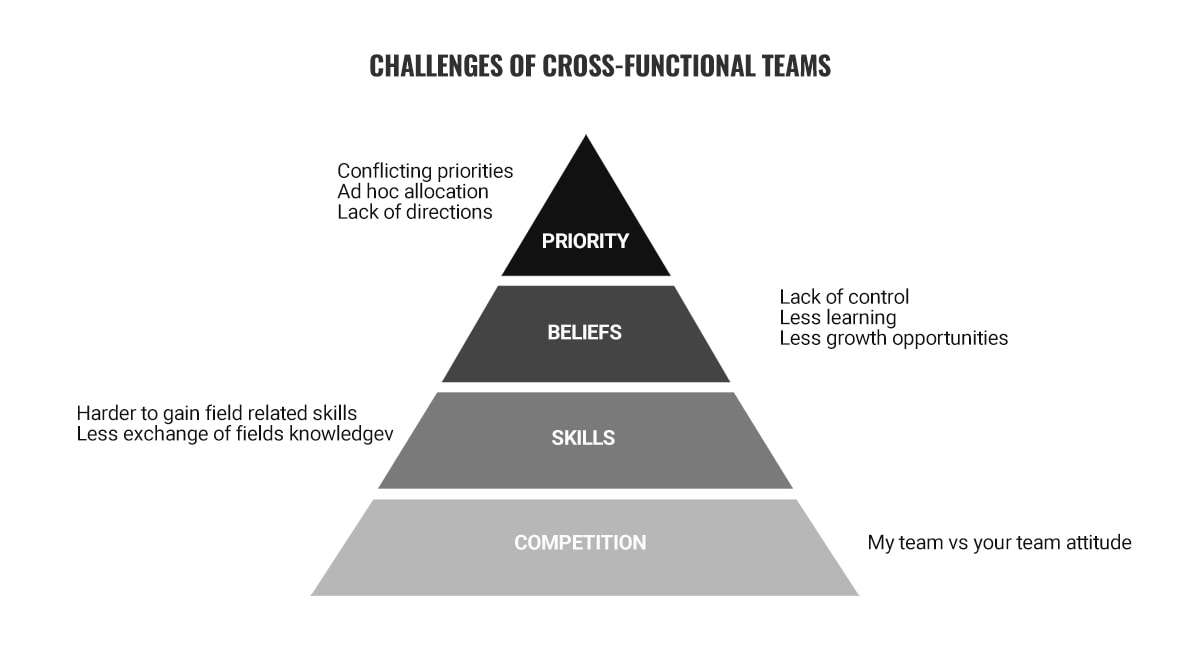If you’ve ever been part of a team at work, chances are it was a functional team – a group of people with similar skills and expertise working together toward a common goal. But what happens when you bring people together with different areas of expertise and perspectives to work on a project? That is what is called a cross-functional team. In this guide we explain what a cross-functional team is, how to create one and how you can actually benefit from having one.
TL;DR
Cross-functional teams are groups of people from different departments – such as marketing, finance, and operations – who come together to work on a project or goal. These teams can be a powerful way to drive innovation and achieve business results, but they can also be challenging to manage and lead.
Example of a Cross-Functional Team
To understand cross-functional teams better, let’s look at an example. Say a company wants to launch a new product. A functional team might include members of the marketing department who focus on promoting the product, while the product development team works on creating the product itself. Those two teams would work separately most of their time. However, a cross-functional team would bring together members from marketing, product development, finance, and operations to work collaboratively on the project. This could lead to a better product launch strategy and provides an opportunity to practice situational leadership that considers all aspects of the business.
When assembling a cross-functional team, it’s important to consider the skills and expertise needed for the project. For example, a product launch team might need expertise in market research, product design, supply chain logistics, and financial forecasting. The team leader should identify potential team members with these skills and invite them to participate.
Diversity as THE Key Characteristic of a Cross-Functional Team
One key characteristic of cross-functional teams is diversity. Because team members come from different departments and backgrounds, they bring a range of skills, experiences, and perspectives to the table. This can lead to better problem-solving and creativity as the team works together to achieve a common goal. And it creates a better understanding of the struggles other departments of the company are facing.
However, diversity can also create challenges in communication and decision-making. Team members may have different priorities or conflicting goals, which can cause tension or delays. To address these challenges, it’s important to establish clear goals and expectations, provide ongoing communication and feedback, and encourage collaboration and mutual respect. Here is a lesson we learned at teamazing: Make sure, that the successes of a cross-functional team are recognized as such.
How Do You Make a Team Cross-Functional?
To make a team cross-functional, you need to identify the necessary skills and expertise for the project or goal and then bring together individuals from different areas of the business who possess those skills. It’s also important to ensure that everyone understands their role and responsibilities, and that communication is clear and open throughout the project. While you are in the process of creating a cross-functional team, you can use a DISC-test to get a sense of your soon-to-be team members characteristics. This can have a drastic effect on the harmony inside a newly established team.
In addition, team leaders should provide opportunities for team members to build relationships and get to know each other. This can help build trust and foster a sense of shared purpose. We at teamazing use regular virtual team buildings to establish those values.
What Are the Benefits of Cross-Functional Teams?
There are many benefits to using cross-functional teams. After all, there is a reason we at teamazing have built an organizational structure that is heavily focused on cross-functional teams. Benefits including:
- Increased innovation and creativity: By bringing together people with different skills and perspectives, cross-functional teams can generate more ideas and develop new approaches to problem-solving.
- Better decision-making: Cross-functional teams can leverage the expertise and knowledge of each team member to make more informed decisions and solve complex problems.
- Improved project outcomes and results: By working collaboratively and taking into account multiple perspectives, cross-functional teams can achieve better results than functional teams working in isolation.
- Increased collaboration and teamwork: Cross-functional teams require strong collaboration and teamwork to be successful, which can foster a positive and productive work environment. And brings people together on an emotional level.
- Better use of resources and expertise across the organization: Cross-functional teams can tap into the resources and expertise of different departments and areas of the business, leading to more efficient and effective use of company resources.
What Are Cross-Functional Skills?
Cross-functional skills are those that are valuable across multiple areas of a business, such as communication, problem-solving, and teamwork. These skills are especially valuable in cross-functional teams, as team members need to work effectively with individuals from different departments and backgrounds. Developing cross-functional skills can help employees become more well-rounded and valuable to their organization. These skills should also be considered a must for employees working in cross-functional teams.
What Is the Best Way to Work Cross-Functionally?
We found the best way to work cross-functionally is to prioritize open communication, collaboration, and flexibility. Cross-functional teams should establish clear goals and expectations for the project, as well as a shared understanding of the roles and responsibilities of each team member. It is essential to provide ongoing support and resources to help team members achieve their goals.
Effective communication is crucial in cross-functional teams, as team members bring different perspectives and expertise to the table. Each team member should listen carefully to others, ask questions, and provide feedback. Regular check-ins and updates can help to ensure that everyone is on the same page and that the project stays on track.
Collaboration is also key in cross-functional teams, as team members must work together to achieve a common goal. This may involve compromising and finding solutions that work for everyone. So companies with a healthy error culture and experience in conflict management will experience a smoother transition towards a cross-functional team structure.
And there is Flexibility: This comes into play, as unexpected challenges can arise. Team members should be open to new ideas and approaches and be willing to adapt to changing circumstances. This may involve rethinking priorities, shifting timelines, or adjusting expectations. Still remember the DISC-Test? A team with an overload on strong egos might have difficulties embracing those changes.
How Do You Describe Cross-Functional Collaboration?
Collaboration is where a lot of newly formed cross-functional teams initially struggle. In a cross-functional context, far too often important technical and organizational factors are overlooked. While cross-functional collaboration is often used as a synonym for team work, we at teamazing define it as a set of tools and rules, that foster communication and fast decision-making. Here are three questions you want to ask yourself before establishing a new team:
- What communication tools will be used and is everyone committed to them? (e.g., are we using gather or MS Teams?)
- Are there rules to ensure that there are no bottlenecks within our communications? Fix dates for Jour Fixes, response time rules or an open-schedule culture are part of our own rule set at teamazing.
- A clear hierarchy for decision-making: it is perfectly fine to have a flat hierarchy as we do, but when it comes to an agile decision-making, a clear “chain of command” is key.
What Are the Three Main Roles That You Would Find in a Cross-Functional Team?
Typically, there are three main roles you would find in a cross-functional team: The project manager, subject-matter experts, and team members.
The project manager
This person responsible for managing the project and ensuring that it stays on track and meets its goals. It involves developing and communicating project plans, tracking progress, and identifying and resolving issues as they arise.
Subject-matter experts
Those are individuals with specific knowledge and expertise in a particular area who contribute their skills to the project. These team members bring valuable expertise to the table, as well as a deep understanding of their departmental goals and priorities.
Team members
Team members are individuals who bring their diverse skills and perspectives to the project and work collaboratively to achieve its goals. They must be open to new ideas and approaches, and be willing to collaborate and compromise to find solutions that work for everyone.
Permanent cross-functional teams at teamazing
While the concept of cross-functional teams is often project-based, we at teamazing took it a step further. At the lowest level of our very own organizational structure, we work in permanent cross-functional teams, we call “boats”. These boats are a mixture of different talents, working together for a well-defined goal. For example, each boat has its own marketing manager. While all marketing managers do meet regularly to share insights and work on their skill-sets, they all focus on the very specific tasks of their “boat”. Here are our very own findings when it comes to the benefits of cross-functional teams:
- Less “siloing”: we don’t see the common “we against them mentality” in our company.
- Better understanding: By working together with people from different backgrounds, we experienced a better understanding of the often complex problems our colleagues face in their daily work.
- Self-development: To a certain extent, we become the people we are surrounded by. Working within divers teams did make us more open-minded.
Disadvantages of cross-functional teams
While cross-functional teams are a great tool if implemented carefully, they are also not free from potential disadvantages. Here are some obsticals you might face on your way to a divers team:
- Conflicting Priorities: With members coming from different areas of the business, there may be differences in priorities and goals. Conflicts and difficulty in making decisions could be a result.
- Communication Barriers: Due to the diverse backgrounds and skill sets of team members, it can be challenging to establish clear communication and understanding. After all, once established habbits can be hard to get rid of.
- Lack of Accountability: With so many individuals involved in a project, it can be challenging to determine who is responsible for specific tasks and outcomes. This can lead to a lack of accountability and ownership, resulting in delays or incomplete work.
- Time and Resource Constraints: Bringing together individuals from different departments and areas of expertise can require significant time and resources to manage, resulting in increased costs and delays in project completion.
- Resistance to Change: Some team members may resist change, making it difficult to implement new processes or ideas, which can hinder progress and limit innovation. A careful selection of team members is key.
One way to tackle problems on a team level is team development. Here is our extensive team development guide.
![]() Interesting Havard Business Review read: “What cross-funtional teams need to succeed”
Interesting Havard Business Review read: “What cross-funtional teams need to succeed”
Conclusion
In conclusion, cross-functional teams can be a powerful way to drive innovation, creativity, and business results. But it is also a transition process you don’t want to underestimate. To ensure success, cross-functional teams must prioritize open communication, collaboration, and flexibility, as well as develop a shared understanding of project goals and roles and responsibilities. By working effectively in cross-functional teams, employees can become more well-rounded and valuable to their organization, while achieving greater success and driving innovation. At least we did.





